Taugh task ahead
 K R Sudhaman
K R Sudhaman
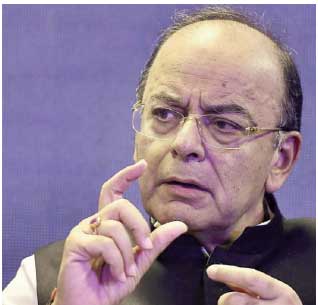 Arun Jaitley
Finance Minister Arun
Jaitley might put up a
brave face, but the
economic situation on
the external front in
particular is none too
bright. He may laud over the 8.2
per cent GDP growth achieved in
the first quarter of this financial
year but he will have to resort to
tight rope walk to ensure that
macro-economic fundamentals
are strengthened to ward off a
potential economic crisis arising
out of free fall of the rupee and
ever widening current account
deficit (CAD). It is not an easy
task.
Arun Jaitley
Finance Minister Arun
Jaitley might put up a
brave face, but the
economic situation on
the external front in
particular is none too
bright. He may laud over the 8.2
per cent GDP growth achieved in
the first quarter of this financial
year but he will have to resort to
tight rope walk to ensure that
macro-economic fundamentals
are strengthened to ward off a
potential economic crisis arising
out of free fall of the rupee and
ever widening current account
deficit (CAD). It is not an easy
task.
There appears to be no
thinking in the Modi
government on how to manage
the economy. For the last four
and a half years, it had a golden
opportunity to resort to big
ticket exports reforms to take
advantage of global economic
recovery. But Modi’s economy
managers slept over it and
instead, as former commerce
secretary Rahul Khullar, says,
implicitly pursued strong rupee
policy. Banking on low crude oil
prices and low CAD resulted in
rupee appreciating nearly 20
per cent.
Apparently many in the
government felt that stronger
rupee meant a stronger
economy.And did not put in
place a policy that could have
boosted exports cashing in on
the global trade that has
registered an impressive
growth of over 4 per cent from
2016 onwards. So much so, the
bonanza that the government
had due to lower oil prices, was
frittered away.
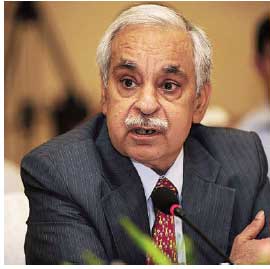 Rahul Khullar
Jaitley might express confidence of maintaining fiscal
deficit at the targeted level of 3.3
per cent of GDP this fiscal but it is
going to be challenge.
Disinvestment target of nearly
one lakh crore rupees for this
year appears to be far cry at the
moment. His claim of control over
inflation might not last long since
fuel prices are skyrocketing in the
face of free fall of rupee and
widening CAD, which may surge
towards three per cent of GDP.
The Reserve Bank of India,
(RBI), might be forced to increase
short term rates two more times
to rein-in inflation, which is
surging in the face of additional
liquidity being pumped into the
system due to dollar buying to
check rupee volatility. Also, core
inflation is rising; so is food
inflation due to higher MSP.
Rahul Khullar
Jaitley might express confidence of maintaining fiscal
deficit at the targeted level of 3.3
per cent of GDP this fiscal but it is
going to be challenge.
Disinvestment target of nearly
one lakh crore rupees for this
year appears to be far cry at the
moment. His claim of control over
inflation might not last long since
fuel prices are skyrocketing in the
face of free fall of rupee and
widening CAD, which may surge
towards three per cent of GDP.
The Reserve Bank of India,
(RBI), might be forced to increase
short term rates two more times
to rein-in inflation, which is
surging in the face of additional
liquidity being pumped into the
system due to dollar buying to
check rupee volatility. Also, core
inflation is rising; so is food
inflation due to higher MSP.
Falling rupee is a doubleedged
weapon. It helps exports,
particularly when it is on a
recovery mode. But it makes
imports expensive. India
imports 80 per cent of its crude
oil requirement. Free fall of
rupee now at over Rs 72 to a
dollar and that too volatile,
makes it risky for the economy.
CAD is widening in India
because of two reasons --
Demonetisation and hasty rollout
of game-changing Goods and
Services Tax. Both measures
impacted the informal sector,
which accounts for nearly 80 per
cent of the jobs.Nearly 45 per
cent of India’s exports are mainly
from the labor-intensive sectors
like leather, textiles, handlooms,
handicrafts, gems and jewellery.
This informal sector also caters to
the large domestic market as well
accounting for nearly 40-50 per
cent consumption of manufactured goods.
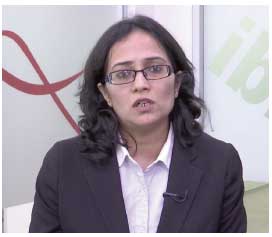 Upasana BharadwajWith demonetization hitting
the informal sector domestic
consumption of locally
manufactured goods have been
substituted by cheap imports
from China. Moreover, Modi’s
Make in India campaign is not a
success story. This is clear from
huge imports of electronics
goods, which is next only to oil
and gold imports.
Low export - high import
syndrome has therefore
widened trade deficit and
current account deficit alike,
much more than desirable
level.Trade deficit is expected
to be a record $200 billion and
CAD to peak to an
unsustainable level of nearly 3
per cent of GDP this financial
year.Falling rupee value has
worsened the situation.It is
time for some correction,
which, of course, has to be
orderly.
Upasana BharadwajWith demonetization hitting
the informal sector domestic
consumption of locally
manufactured goods have been
substituted by cheap imports
from China. Moreover, Modi’s
Make in India campaign is not a
success story. This is clear from
huge imports of electronics
goods, which is next only to oil
and gold imports.
Low export - high import
syndrome has therefore
widened trade deficit and
current account deficit alike,
much more than desirable
level.Trade deficit is expected
to be a record $200 billion and
CAD to peak to an
unsustainable level of nearly 3
per cent of GDP this financial
year.Falling rupee value has
worsened the situation.It is
time for some correction,
which, of course, has to be
orderly.
Falling rupee is not too big
a worry right now, says
noted economist,
Raghuram Rajan. The
Indian rupee has not
depreciated to a worrying
level. It has weakened
nearly 10 per cent so far
this year making it the
worst performing Asian
currency though. It is
dollar’s strength that is
depreciating many
emerging market
currencies. So Rajan’s
advice: Stop worrying
about rupee. Instead
strengthen India’s
macroeconomic
fundamentals.
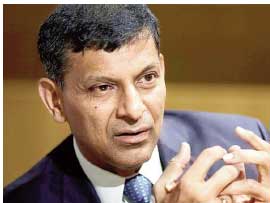 Raghuram Rajan
Recipe is not checking exports.
But export drive through massive
reforms, and steps to attract
labor-intensiveChinese export
units to shift base to India. At the
moment most of them are going
to Vietnam, Cambodia, and
Bangladesh.The Chinese will turn
to India particularly in textiles
and leather if only the
government gives them some
incentives, creates a conducive
environment and cuts the red
tape.
Raghuram Rajan
Recipe is not checking exports.
But export drive through massive
reforms, and steps to attract
labor-intensiveChinese export
units to shift base to India. At the
moment most of them are going
to Vietnam, Cambodia, and
Bangladesh.The Chinese will turn
to India particularly in textiles
and leather if only the
government gives them some
incentives, creates a conducive
environment and cuts the red
tape.
Import controls will not help
in finding a permanent solution
to the problem of widening
CAD. Knee-jerk reactions will
lead India nowhere. Boost
Exports mantra is what India
needs even if the government
regulates non-essential imports
like high-end items.
The Government recently
announced some measures to
attract additional capital inflows
of $8-10 billion. And eased
external commercial borrowing norms. Kotak Mahindra Bank
economist Upasana Bharadwaj is
not sure how much capital flow
will come from these twin steps,
which are also aimed arresting
the free fall of rupee. Why would
there be some capital inflows or
why domestic companies borrow
from abroad when investment
climate is uncertain? This is an
issue the government will do to
grapple with without much ado.
“I am puzzled…. They
(government) seem to be
sending out wrong signals,”
says Pronab Sen, formerly
India’s chief statistician. This
gives an impression that the
government is panicking, and it
will only worry investors and
encourage speculators, he
remarked.
Even with current account
deficit at 2.5 per cent of GDP
India could still grow at 8 per
cent. If it breaches 3 per cent of
GDP, it will be a matter of
concern.
Falling rupee is not too big a
worry right now, says noted
economist, Raghuram Rajan. The
Indian rupee has not depreciated
to a worrying level. It has
weakened nearly 10 per cent so
far this year making it the worst
performing Asian currency
though. It is dollar’s strength that
is depreciating many emerging
market currencies. So Rajan’s
advice: Stop worrying about
rupee. Instead strengthen India’s
macroeconomic fundamentals.
Bringing down current account
deficit and maintaining fiscal
deficit are equally, if not more,
important. This will make
investors more confident and
economy would get kick-started.
The government has since
announced an array of steps to
boost exports. It has removed
withholding tax on masala bonds,
and relaxed restrictions on nonportfolio
investments and on
some non-essential imports.
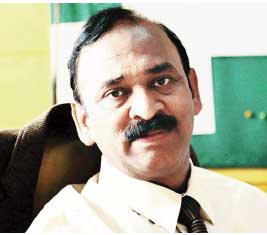 Ajay Sahai
Easing of liquidity to exporters
at this juncture may be a good
idea since exports are looking up
in the last couple of months. FIEO
director General Ajay Sahai also
subscribes to this view.
Ajay Sahai
Easing of liquidity to exporters
at this juncture may be a good
idea since exports are looking up
in the last couple of months. FIEO
director General Ajay Sahai also
subscribes to this view.
India’s share in goods
exports is under two per cent in
the global basket whereas
China accounts for nearly 14
per cent. But in Services
exports our performance is
slightly better at around 3.5 per
cent.India must strive to
become a global exports hub if
right policy is put in place to
push both goods and services
exports.
A working paper of the Finance
Ministry that has been gathering
dust for a long while has offered
blueprint to take India’s share in
World exports to a respectable
five per cent. For this India’s
goods exports should reach $882
billion by 2022, which means a 27
per cent growth rate in five years.
This is not impossible as India
had witnessed a much higher
exports growth during 2004-09.
Arun Jaitley has an
unenviable task, namely
avoiding fiscal slippages
and warding off the illeffects
of surging fuel
prices. How he goes
about addressing these
challenges will have a
bearing on Moditva
2019.
India’s goods exports have to
be made demand based rather
than supply based as at present.
Regarding services exports, there
is a need for ‘Services from India initiative like the ‘Make in India’
plank to promote manufacturing
and exports from the country.
Tariff rationalization is the
call of the day. Though average
customs duty is around 10 per
cent, the real applied duty is
around 2.8 per cent because of
various exemptions provided.
This is creating distortions.
India has moved up on the
“Ease of Doing Business” index,
no doubt but itis still much
behind many ASEAN countries
in trading across borders. Some
specific steps will be in order
more so since the US-China
trade war is dangling some low
hanging fruits.
Well, Arun Jaitley has an
unenviable task, namely avoiding
fiscal slippages and warding off
the ill- effects of surging fuel
prices. How he goes about
addressing these challenges will
have a bearing on Moditva 2019.
(K R Sudhaman, a senior
journalist, has been Editor
in Press Trust of India and
Economics Editor in
Financial Chronicle and
TickerNews)




 K R Sudhaman
K R Sudhaman Arun Jaitley
Arun Jaitley Rahul Khullar
Rahul Khullar Upasana Bharadwaj
Upasana Bharadwaj Raghuram Rajan
Raghuram Rajan Ajay Sahai
Ajay Sahai